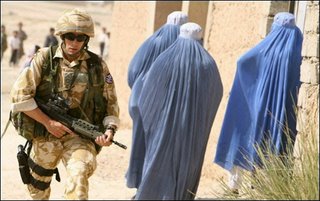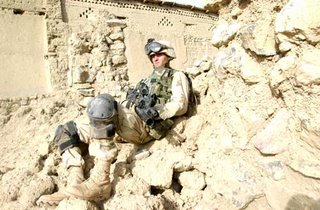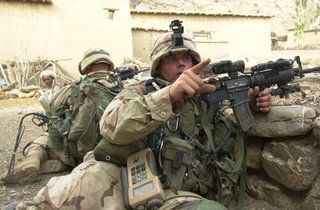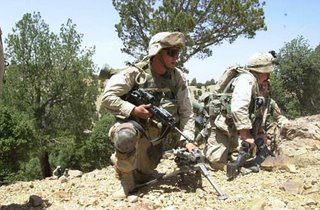*****
Lashkar Gah, Helmand Province, 11 AM: A suicide bomber on foot threw himself at a NATO convoy here as it left the Afghan National Police Station and killed 4 people - himself, 2 civilians and 1 British Royal Marine, Gary Wright. 5 NATO soldiers were wounded, 1 of them very seriously. A British jeep was engulfed in flames after the attack.
 An overhead shot of Lashkar Gah. This city was built up by the US government 30 years ago as part of an aid project, and many locals worked on that project and are nostalgic for the beneficent US government of the 1970's.
An overhead shot of Lashkar Gah. This city was built up by the US government 30 years ago as part of an aid project, and many locals worked on that project and are nostalgic for the beneficent US government of the 1970's.I suppose the Bush reactionaries feel that all aid money is "socialism" - after all, it goes to build roads, schools and hospitals with "government spending", all of which the Republican Party opposes at home and in all US third world allies. Since they oppose such social spending at home and in most of its allies, what makes anyone think that the Bushies are not ideologically opposed to "socialist" aid in Afghanistan? Is such aid not a violation of the free market mantra?
*****
Korengal, Pech District, Kunar Province, Late: Guerrillas stopped a vehicle containing 10 workers who were coming home from work at a nearby US military base, stole $6,000 from them, and then executed 8 of them. 2 of the workers somehow managed to escape.'
Paktika Province, Late: A dozen Taliban attacked a district here. Police fired back, killing 1 Taliban and wounding 5 more. This attack is probably the same as the Sanjay Ghar air strike in the Wor Mamay District detailed below.
*****
Lashkar Gah, Helmand Province: In a separate attack, a suicide bomber on foot targeted attacked a British aid group's vehicle here, damaging the vehicle, killing himself and 1 civilian, while wounding 4 more civilians.
 A British soldier passes burka-clad women in Lashkar Gah on March 16, 2006. Most women in this city wear the burka the whole time they are outdoors. Helmand, believe it or not, never supported the Taliban very much, because they tried to eradicate the opium crop. Opium is God in these parts.
A British soldier passes burka-clad women in Lashkar Gah on March 16, 2006. Most women in this city wear the burka the whole time they are outdoors. Helmand, believe it or not, never supported the Taliban very much, because they tried to eradicate the opium crop. Opium is God in these parts.Locals are very poor and borrow money from crooked warlord/landowners in a semi-feudal situation. After the farmers' opium crop is eradicated, the farmer now cannot pay back the loan money he borrowed to farm the land. As payment, the landowner may demand, say, one of the farmer's daughters as a wife.
All of the Afghan provincial governments are in on the heroin/opium business in one way or another and so are at least in parts of every government agency under Karzai. Typically, a small percentage of the land is set aside to be eradicated by the narcotics police (say, 10%) then the rest is harvested and the cops are paid off.
Khost: A suicide bomber threw himself at an Afghan police car just outside this city, killing himself and a policeman while wounding 4 other police.
Bar Kanday, Pech District, Kunar Province: US Air Force A-10 Thunderbolt IIs attacked guerrillas fighting US troops near here. The jihad in this area is reportedly being led by Gulbuddin Hekmatyar's Hezb-i-Islami. The Bar Kanday area is being bombed regularly by US forces in recent weeks. Bar Kanday (map) is located 13 miles west of Asadabad in the Pech River Valley.
*****
Sanjay Ghar Mountain, Wor Mamay District, Paktika Province: US Air Force B-1 Lancers attacked guerrillas fighting US troops near this mountain. Sanjay Ghar Mountain is located near the town of Rahmatullah Khan Kalay.
Rahmatullah Khan Kalay (map) is located 10 miles northeast of Wor Mamay, the capital of the district. Wana, the capital of South Waziristan, is 39 miles to the east. There is a fair amount of fighting in this remote region. In all of the areas of Greater Paktia (Paktia, Khost and Paktika Provinces), the Afghan government is weakest in Southern and parts of Eastern Paktika and Southern Ghazni.
The Wor Mamay District is in southern Paktika. It is mandatory that a comprehensive security, governance and reconstruction regime be implemented in these regions at once as there is presently no comprehensive government or NATO counterinsurgency program to combat the guerrilla insurgency.
Paktika and Ghazni Province need 2 NATO infantry battalions each, or a doubling of strength from their current level.
*****
Wednesday, October 18
****
Darya-I-Baghlan, Border Between the Baghlan and Puli-i-Kurmi Districts, Baghlan Province: US Air Force A-10 Thunderbolt IIs attacked guerrillas who were fighting ISAF forces near here. The Darya-i-Baghlan is a river in Baghlan Province.
It begins just west of the city of Baghlan, the capital of Baghlan Province, between the towns of Puzai Esan (map here) and Omar Khel (map here). I really do not know why US planes are doing bombing Baghlan Province, which is in the far north and has not seen much fighting.
*****
Worzhanah Kalay, Urgun District, Paktika Province: US Air Force A-10s and an Air Force B-1 Lancer attacked guerrillas fighting US forces near here. Worzhana Kalay (map here)is located about 10 miles north of Urgun, the main market town in Paktika Province. North Waziristan is located just east of here, which is partly why this has traditionally been one of the most dangerous areas in Afghanistan for US troops.
Tuesday, October 17
Bagh-Khosak, Shahidi Hassas District, Uruzgan Province, 1:01 AM: US warplanes dropped three 500-pound bombs on Taliban forces in the Khod Valley here, killing a senior commander and an additional 10-15 Taliban. Bagh-Khosak (map here) is located 10 miles north of the capital, Shahidi Hassas, on the Varkhan River in what appears to be very wild and high-altitude terrain.
*****
Tajikan, Nahri Sarraj District, Helmand Province, 10 PM: A large group of Taliban attacked a police checkpoint here, setting off a 4-hour battle between the Taliban and NATO soldiers and Afghan security forces that killed 13 civilians and 1 Taliban fighter.
3 police were also wounded. During the fighting, a rocket fired from a NATO jet hit a house, killing the 13 civilians. After several hours of fighting, the Taliban fled. News reports give the name of the town as Tajikai, but it is actually Tajikan. Tajikan (map here) is located right next to Gereshk, the main city in the district.
British Royal Air Force Harrier GR-7s attacked Taliban forces during this fighting, and according to this report, fired rockets at enemy targets. Therefore, it was clearly a rocket from a British Harrier that killed the 13 civilians here.
*****
****
Ashoqa, Zhari District, Kandahar Province, Night: NATO air strikes here hit 3 homes, killing 9 civilians and wounding 11 more while the victims slept. NATO said an unknown number of Taliban were also killed. However, the governor of Kandahar said that no Taliban were killed in the raid.
The operation was intended to interdict Taliban fighters who were laying roadside bombs in the area. The name of this town was given as Ashogo in news reports but it is actually called Ashoqa. Ashoqa (map here) is located 15 1/2 miles west of Kandahar.
*****
Darashot and Azo, Chitral District, Pakistan: NATO planes bombed these 2 villages along the border with Afghanistan. The bombs set the nearby forest on fire. The name of the town was given in the report as Daroshot, but the actual name of the town is Darashot. Azo could not be located on any map.
Darashot (map) is located 2 1/2 miles east of the Afghan town of Gawhardesh, in the Nari District in the far northeast corner of Kunar Province. The Nari is mountainous, forested and remote.
It is 60% Pashtun and the remaining 40% are divided into various Nuristani, Gujur and Kohistani groups. The Gujur speak a language that is related to Hindi and Urdu but is quite close to Gujarati and Rajasthani. The Kohistanis speak a language related to Kashmiri.
Both groups were formerly Hindus who were converted to Islam in the 1000's, and both retain traces of their Hindu or even pre-Hindu religions, especially the Gujur. For instance, the Kohistanis believe in the presence of ghosts, spirits, gods, demons, fairies and ancestral spirits. Shamans are utilized to cure the sick, communicate with gods and control worldly events.
The Gujur are an interesting people. Gujurs are descended in part from Sythians, Georgians, Khararians who took part in the "Scythian" (sometimes referred to as Turko-Iranian) invasions of India from 1900 to 2500 years and Parthian Greeks, along with lesser understood peoples like Ephthalites or "White Huns" and Tokharians or Yue-Chi, an Indo-European-speaking people from Western China.
Parthians invaded Northern India 2100 years ago and "White Huns" invaded 1500 years ago.
A Dr. Huthi from Georgia came to India and investigated the Gujurs and attempted to develop a theory that they came from Georgia, all the way down to their name - Gujur - which was said to be related to the Persian word for Georgians - Gujris. This would go along with general thinking that the Gujurs have part-Caucasian (Georgian, Chechen, etc.) heritage.
These people mostly settled in the Punjab, Gujarat and Kashmir and interbred with local Indo-Aryan speaking peoples. Gujurs also appear to have interbred with native Indian peoples. These groupings developed Buddhist and sun-worshipping kingdoms that ruled much of Afghanistan and Pakistan and a good part of India.
While there are only 2,000 Gujurs in Afghanistan, there are 33 million in Pakistan and another 30 million in India. All Afghan Gujurs are Muslim, but the Gujurs of India and Pakistan have many Sikhs and Hindus amongst them.
The lives of the Gujur have in general been difficult since they converted to Islam. The Gujur originally lived in northern India exclusively. Islamic invaders swept into India in the 1000's, and at this time, the Gujur converted to Islam.
Most of their Hindu neighbors refused to convert, and the Gujur incurred the wrath of their Hindu neighbors, who forced them to leave the area and turn into wandering herders. They wandered into what is now Pakistan and Afghanistan. Since their conversion to Islam, their lives have been marked by poverty, oppression and illiteracy, even though they are generally a peaceful-minded people.
In India, they are still treated with contempt by higher-caste persons who regard them as thieves and vagrants, even though as Muslims they are totally outside the disgusting caste system. The Gujur in Kashmir are often cheated by "middlemen" who take their products to market, sell them and refuse to pay the Gujur.
The Gujur in Afghanistan are a Gypsy-like wandering people who work as tinkers (those who mend small objects), musicians, traders and fortune-tellers. They are often extremely poor and a number have been driven to begging and petty crime. Others are wandering goat-herders who travel the mountain valleys in the summers.
In Chitral in northern Pakistan, some Gujurs are also nomadic, and in the summer have huts as high as 9,000 feet where they graze their goats and travel rocky trails. They probably live similar lives in Kunar.
In Pakistan, some Gujur groups have done well economically and hold an economically-dominant position in some places. Despite the fact that they are Muslims, the Muslim Gujur often also worship a "family deity" and celebrate certain Hindu holidays such as Holi. Because they share some Hindu beliefs and holidays, they are not accepted well by other Muslims.
People in the Nari District mostly support themselves by timber harvest, although they also raise wheat and corn. There is only one mobile clinic in the entire district thanks to George Bush's glorious reconstruction of Afghanistan, and as such most people are taking the sick to Asadabad, which is 50 miles away on a terrible road. As such, a number of the sick are dying along the way to the clinic.
Others try to go to Pakistan for treatment, especially pregnant women. But since the border is now closed, they cannot make it across the border. Thus, a number of pregnant women have died. Since the fall of the Taliban, the number of schools has almost tripled. Many girls are in school. Idiotically, the schools have only walls, with no roofs, doors or windows! This is because the crooked development agency did not even pay its workers.
The villagers have since built doors, windows and roofs for themselves. There are actually 14 female teachers but they are all working without pay for some idiotic reason.
*****
Kamdesh District, Nuristan Province: Guerrillas attacked a US convoy here, damaging a US vehicle. US forces came to the aid of the convoy and returned fire, killing up to 14 guerrillas. The Taliban claimed that 10 US troops were killed, but that is apparently not accurate.
*****
Afghanistan: Wrap up on wounded British troops - For the period of January 1, 2006 to September 30, 2006, 70 British military and civilian personnel were admitted to medical facilities and categorized as Wounded in Action. 53 more British military and civilian Personnel were admitted to the hospital with non-battle injuries.
14 British personnel were categorized as Very Seriously Injured from all causes, excluding disease. 9 more British personnel were categorized as Seriously Injured from all causes excluding disease. 198 British personnel were airlifted from Afghanistan on medical grounds for whatever reason.
*****
Paktia Province: US and Afghan forces battled the Taliban here, killing up to 20 guerrillas.
*****
Gol Kowt, Gayan District, Paktika Province: Afghan soldiers battled the Taliban here for 5 hours and 24 Taliban were killed. Both sides used automatic weapons, heavy machine guns and RPG's. 5 more Taliban were wounded but escaped. 1 Afghan soldier was killed. A US air force report said that a US Air Force B-1 attacked guerrillas fighting Coalition forces near Gol Kowt.
Although the news reports gave the location of the fighting as Bermal, it probably actually took place in Gol Kowt, as Gol Kowt is only 12.5 miles north of Bermal. There has been a lot of bombing around this area lately. The Gayan District is right across from North Waziristan. Gol Kowt (map here and here) is located 12 1/2 miles north of Bermal and 12 miles west of the Pakistani border.
*****
Garmser District, Helmand Province: Fighting between Afghan police and the Taliban here killed 4 Taliban. 6 more Taliban were arrested afterwards. 1 policeman was wounded.
Musa Qala District, Helmand Province: British forces are completing their pullout from this hostile district after brokering a truce with local elders 6 weeks ago. The Taliban said that after the pullout, the Afghan government flag would not fly in the district anymore. I am not sure if that counts as a victory or what?
Spin Boldak, Spin Boldak District, Kandahar Province: The Taliban fired rockets at an oil tanker delivering oil to Coalition forces in Kandahar at a border crossing here, destroying the tanker and killing the Pakistani driver.
Bez Bel: A US Air Force B-1 Lancer attacked guerrillas fighting NATO forces near here. This town could not be located on any map.
Now Zad, Helmand Province: US Air Force A-10 Thunderbolt IIs provided close-air support to British troops fighting the Taliban near here. in contact with enemy forces near here. There is regular fighting around here with no end in sight.
Kuh-e Pahsakhvan: US Air Force A-10 Thunderbolt IIs attacked guerrillas fighting NATO troops near here. This town could not be located on any map.
Monday, October 16
*****
Dorahi District, Kandahar City, 12:30 PM: Suicide car bomb attack on a Canadian resupply convoy in the center of Kandahar killed the bomber and 3 civilians. One NATO soldier and 4 Afghan civilians were wounded in the attack. Smoke rose from a destroyed Canadian vehicle after the attack.
Canadian troops opened fire afterwards, wounding one Afghan man, Mohammad Server, who was in a mosque at the time. Server works as a cook for the Afghan police. Canadian forces denied that anyone was hurt by the "warning shots" that they fired after the bomb hit, despite Server's wounds and testimony.
 A market scene in Kandahar City. Notice that there are not too many men about here. Kandahar is actually Ground Zero of the Pashtuns of Afghanistan. Kandahari Pashtuns, especially Durranis like Karzai, have ruled Afghanistan for the last 200 years or so, similar to the Sunnis of Iraq. It is the similar feeling of rage by an elite that has lost its power that in part drives the Taliban insurgency.
A market scene in Kandahar City. Notice that there are not too many men about here. Kandahar is actually Ground Zero of the Pashtuns of Afghanistan. Kandahari Pashtuns, especially Durranis like Karzai, have ruled Afghanistan for the last 200 years or so, similar to the Sunnis of Iraq. It is the similar feeling of rage by an elite that has lost its power that in part drives the Taliban insurgency.The Ghilzai Pashtuns have generally not been the ruling class, except for Mullah Omar, who was a poor Ghilzai farmer. The Pashtuns in general feel that their Tajik (or Persian, as the Pashtuns see them) rivals now rule Afghanistan.
Part of the gripe is that Dari (a dialect of Persian spoken by Tajiks) is now virtually the official language of Afghanistan, with Pashtun, though officially a state language, being relegated to a far distant second. The treatment of the Pashtun language under Karzai is surely unfair.
 A great street scene of Kandahar city. To the west in the Panjwayi District, there is a great deal of opium production. Opium growers feel they are being singled out for eradication efforts, in particular certain tribes. Their anger at having their opium crops eradicated, in part, drives the Taliban resurgence in this province.
A great street scene of Kandahar city. To the west in the Panjwayi District, there is a great deal of opium production. Opium growers feel they are being singled out for eradication efforts, in particular certain tribes. Their anger at having their opium crops eradicated, in part, drives the Taliban resurgence in this province.Another reason is the vast corruption. The local police have often not been paid in months and locals complain that they are all thieves. Driving west out of Kandahar City, one encounters roadblock after roadblock of Afghan troops demanding bribes. The bribes are only 20 cents or so, but it adds up after a while, and Afghans are very poor.
You can say what you will about the Taliban, but they were not corrupt. It is a failure of the NATO forces that they have stood by and allowed the Karzai Administration to become so corrupt. This corruption is surely fueling the Taliban resurgence.
*****
Kabul: Suicide bomb attack on an unknown target near a school on the road linking the US Embassy with the airport wounded 3 civilians.
Ghazni Province: US and Afghan forces backed by US warplanes attacked the Taliban in a mission directed at a bomb-making compound, killing 3 Taliban. 1 US soldier was wounded in the fighting.
Band-e Kajaki, Kajaki District, Helmand Province: US Navy F/A-18s and British Royal Air Force Harrier GR-7s attacked Taliban forces fighting British troops near here. Band-e Kajaki is located right under the Kajaki Dam on the Helmand River. There has been regular fighting and Coalition aircraft bombing here for weeks now with no end in sight.
Akhtaro Kalay, Gayan District, Paktika Province: US Navy F/A-18s attacked guerrillas fighting US troops near here. Akhtaro Kalay (map here) is 17 miles west of Urgun, 16 miles northeast of Bermal and 5 1/2 miles west of the Pakistani border. The Gayan District is seeing a lot of fighting and bombing by Coalition aircraft lately. North Waziristan (Al Qaeda Central) is right across the border.
Sunday, October 15
******
Korengal, Pech District, Kunar Province, Night: Guerrillas attacked US forces here with RPG's and automatic weapons. US troops returned fire, killing 4 guerrillas.
 US forces cover their ears as artillery fire blasts at enemy positions in the Korengal Valley in the Pech District of Kunar Province. Supposedly only one tribe, the Korengali, are fighting US troops here, and have thrown in their lot with Al Qaeda, the Taliban, Hezb-i-Islami and other guerrillas, and the rest of the tribes are with the Afghan government, but I think that is dubious.
US forces cover their ears as artillery fire blasts at enemy positions in the Korengal Valley in the Pech District of Kunar Province. Supposedly only one tribe, the Korengali, are fighting US troops here, and have thrown in their lot with Al Qaeda, the Taliban, Hezb-i-Islami and other guerrillas, and the rest of the tribes are with the Afghan government, but I think that is dubious.This area is very dangerous and is crawling with armed guerrillas who are very well-trained and well-armed. There are quite a few Arabs, Uzbeks and Chechens aligned with Al Qaeda and like groups fighting with the other guerrillas here.
The Uzbeks are with the Islamic Movement of Uzbekistan (IMU) who are now headquartered in North Waziristan with a force of about 1,000 fighters, having fled Uzbekistan after various government crackdowns. 2 US troops were killed here on October 2.
****
Paktia Province: Afghan troops killed 8 Taliban in fighting here.
****
Gangikhel, Bermal District, Paktika Province: French Mirage 2000Ds and a US Air Force B1-B Lancer attacked guerrillas fighting US troops near here. Gangikhel (map here and here)is 10 miles south of Bermal, 8 miles northeast of Shkin and 4 1/2 miles from the Pakistani border.
 After a long march through semi-desert terrain, a US soldier rests in Gangikhel in August 2002. This area is only 8 miles north of Shkin, the location of a US firebase on the Pakistan border which was formerly the most deadly are in all of Afghanistan for US troops.
After a long march through semi-desert terrain, a US soldier rests in Gangikhel in August 2002. This area is only 8 miles north of Shkin, the location of a US firebase on the Pakistan border which was formerly the most deadly are in all of Afghanistan for US troops. Local Afghans in Gangikhel wait as US troops search the village for weapons in August 2002. Note the red beard on the Pashtun Afghan man in the foreground. Red hair is fairly common in this part of the world, interestingly enough, which implies a substantial amount of European genes are present in these Pashtuns. Red hair is thought to have originated in Finland about 10,000 years and then spread to a significant part of the world. The highest rates of red hair are found in Scotland and Ireland.
Local Afghans in Gangikhel wait as US troops search the village for weapons in August 2002. Note the red beard on the Pashtun Afghan man in the foreground. Red hair is fairly common in this part of the world, interestingly enough, which implies a substantial amount of European genes are present in these Pashtuns. Red hair is thought to have originated in Finland about 10,000 years and then spread to a significant part of the world. The highest rates of red hair are found in Scotland and Ireland. US Army Sgt. Brandon Cross directs US forces to take up positions in Gangikhel in August 2002.
US Army Sgt. Brandon Cross directs US forces to take up positions in Gangikhel in August 2002. Chinooks drop off US troops in a mission to interdict enemy forces in Gangikhel in August 2002. The Pakistani border with South Waziristan (Al Qaeda Central) is less than 5 miles away.
Chinooks drop off US troops in a mission to interdict enemy forces in Gangikhel in August 2002. The Pakistani border with South Waziristan (Al Qaeda Central) is less than 5 miles away. US forces take up positions in Gangikhel in August 2002. 4 years later, the area is still highly unstable.
US forces take up positions in Gangikhel in August 2002. 4 years later, the area is still highly unstable. A US soldier rests in Gangikhel after marching through the desert for hours in August 2002. Across the border in South Waziristan, members of what is probably this same tribe, the Gangikhel, a sub tribe of the Wazirs, fought Pakistani forces for years until a truce was recently brokered. There was very heavy fighting with this tribe near Wana in 2004, when Pakistani forces felt that they had surrounded Ayman al-Zawahiri, but it was either a false lead or else he escaped.
A US soldier rests in Gangikhel after marching through the desert for hours in August 2002. Across the border in South Waziristan, members of what is probably this same tribe, the Gangikhel, a sub tribe of the Wazirs, fought Pakistani forces for years until a truce was recently brokered. There was very heavy fighting with this tribe near Wana in 2004, when Pakistani forces felt that they had surrounded Ayman al-Zawahiri, but it was either a false lead or else he escaped. US positions take up positions outside Gangikhel in August 2002. The Pashtuns in this area have fought all foreign forces since Alexander the Great. They are probably not any more enamored of US forces than any other foreigners.
US positions take up positions outside Gangikhel in August 2002. The Pashtuns in this area have fought all foreign forces since Alexander the Great. They are probably not any more enamored of US forces than any other foreigners.******

No comments:
Post a Comment